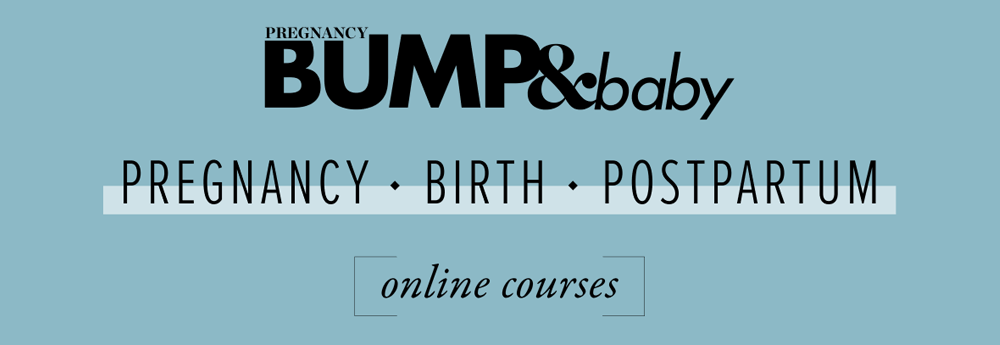
Okay, maybe labour isn’t exactly a party – but it is a special, exciting event! The three stages of labour are a natural process designed to guide your baby into the world.
Every mum’s experience of labour and birth is different, and unfortunately, it’s impossible to predict what yours will be like – when it will start, how long it will last, what it will feel like. But generally, births follow a pattern of three stages, each defined by specific events and milestones.
First stage
The first stage of labour is the longest stage, lasting from six to 36 hours, and itself has three phases: Latent, active labour, and transition. The first stage of labour begins when your contractions start, and goes until your cervix is dilated to 10cm.
PRE-LABOUR
In the days leading up to labour’s start, you may notice changes in your body which will tell you that it’s getting ready for your baby’s arrival:
+ The ligaments in your pelvis may soften due to the hormone relaxin, which in turn can cause you to have a backache, pain in your pelvis or pubic region, and the feeling of waddling when you walk.
+ Your baby may “drop” or engage in your pelvis, head-down, in readiness for birth. This usually happens between 36 and 38 weeks for first-time mums.
+ You may feel like sleeping, laying around, resting and not doing much, or you may feel like going to bed in the middle of dinner and you don’t care what your dinner guests think.
+ Many women have a burst of energy which manifests as “I need to get the garage cleaned out RIGHT NOW” or something similar, quite soon before labour. This is different from general pregnancy nesting, which you’ll experience throughout pregnancy, in that it is intense, emotional, and an inner drive
that you can’t ignore.
+ You may have painless contractions (Braxton Hicks) or period-like cramps (false labour) which carry on for a bit, then fizzle out.
+ You may find you’re going to the toilet more often or have a mild upset tummy as your bowels and bladder empty in preparation for labour.
+ Your cervix will become shorter, thinner, and softer, and the mucous plug in your cervix may come out. Called a “show” or “bloody show”, the mucous looks a bit like jelly and is stained with blood.
The latent phase (early labour)
Early labour can last between eight and 16 hours (although it can be shorter or longer), and you may not even notice the first several hours. In the first stage of labour, your cervix needs to open (dilate) to its full capacity – about 10cm in diameter – so that your baby can be born. In order to help dilate your cervix, the muscles of your uterus contract and help to shorten and soften the cervix. In early labour, it will go from closed to being about 3-4cm dilated. Some women don’t notice they’re in early labour, or they may have mild symptoms such as a backache, dull ache in their pelvis, or cramps.
Usually mums-to-be notice contractions as a reliable sign that they’re in the first stage of labour. While Braxton Hicks contractions are irregular and generally painless, labour contractions are more regular (or fall into a pattern over the course of a few hours), painful, intense and frequent as time passes.
Timing your contractions can help you to know how your labour is progressing. Keep track the old-fashioned way with a pen and paper – note the time at the start of the contraction, then at the end of the contraction, then at the start of the next contraction, etc. Note how long each contraction lasts and how long between each contraction. You may also wish to download a smartphone app which lets you (or your partner) track your contractions, which can be helpful as it’ll do the calculating for you.
Contractions during early labour are usually more than five to 10 minutes apart, lasting only from about 15 to 45 seconds. But every woman’s rhythm and pace of labour is different. Contractions often start off feeling like strong period cramps, with pressure or tightening in your pelvis, and might be accompanied by lower back pain.
Give your midwife a call to let her know you’re in early labour, or if you aren’t sure, call her anyway – she’ll have a number of questions to ask you to help determine whether labour has started.
Unless your midwife or LMC has given you other instructions, or you are concerned, it’s usually best to stay at home during this phase of labour rather than going to the birthing centre or hospital. Walk around to help move things along (but don’t overdo it), sit on a balance ball, rest to conserve your energy, eat, and drink as normally as you can. You should be able to talk and carry out your normal routine (although you may need to pause for contractions). To help you stay relaxed, try massage or TENS to give you some relief from the pain and help your body to go with the flow.
Active labour
During active labour, your cervix dilates from about 3-4cm to the full 10cm. For a first-time mum, this stage of labour can last anywhere from eight to 14 hours, although it is different for everyone. Your contractions will be more powerful and intense, starting gradually and then building up to a peak before they dissipate. At this stage, contractions will also become more frequent, going from 60 to 90 seconds long and from five minutes down to three minutes between them.
Once you’re in active labour, it’s time to go to the birthing centre or hospital. Your midwife will have given you guidelines about when is an appropriate time to come in – usually when your contractions are every five minutes, last longer than 45-60 seconds, and have been getting stronger for the past two or three hours. Check with your midwife for her specific guidelines.
At this stage, you might feel like you “go into yourself”, withdrawing a bit from the world around you as you concentrate on what is happening within. You probably won’t be able to talk through contractions, and you might feel like moaning or doing breathing exercises to get through them. Many women become more vocal as labour progresses, and may not realise they’re making noise – or may not be able to help it. Your LMC has heard it all before, so don’t feel embarrassed.
Relaxation techniques are useful during this phase, so try sitting on a balance ball, massage, and breathing through the contractions as much as you can. It is natural to feel tense during contractions, but if you can try to relax your body and go with them, things will progress faster.
You may also want pain relief during this stage, so talk to your LMC ahead of time, when you are making your birth plan, and decide what kinds of pain relief you are comfortable with so that if and when the time comes you will be prepared
At some point during the active phase of labour, as you are moving into the next phase – transition – you may vomit or void your bowels. This is normal and does not mean you are sick – your body is preparing to concentrate on your baby’s arrival.
Transition
Transition is short, lasting from 30 minutes to an hour and a half. When you’re in transition, you are very close to having your baby. Transition happens at the end of the active phase, when your cervix dilates from about 8-9cm to the full 10cm, and transition ends when your cervix is fully dilated or you feel the urge to push.
Your contractions may be less frequent, but stronger and longer-lasting, coming in double waves or peaking, fading, peaking again, and then fading away. It’s common for your waters to break during or just before transition, and as your cervix becomes fully dilated.
Transition can be intense, and the experience varies for mums-to-be. You may feel like you are zoned into your labour and don’t notice anything around you – the feeling that if strangers came into the room, you wouldn’t care that they were there – and you might only emerge from this insularity to say short sentences or even just words. You might not be able to focus on looking at anything else, and want to shut your eyes. You might feel like curling up with your head down, focusing on your body. You may want to shout, groan loudly, and feel impatient. You may be upset or emotional, and cry. You might feel shivery or shaky. And some women don’t experience any of these things!
It can be helpful for mums-to-be to be told when they’re in transition, as often your midwife or LMC will recognise its telltale signs before you do.
If you’re planning to give birth without pain relief, transition may be the most difficult part of labour, as it is often the most trying and, to a degree, will take you beyond what you thought you could handle. It’s important that you have good support to help you get through this stage. Knowing that transition means your baby is very close can help mums to get through the difficulties of this phase.
What To Expect After The First Stage:
BUMP&baby
BUMP & baby is New Zealand’s only magazine for pregnancy and early babyhood. Our team of mums and mums-to-be understand what it’s like to be pregnant in this connected age, and that’s why BUMP & Baby online is geared toward what pregnant women and new mums really want to know.
Other articles of interest
10 ways to soothe stitches
“A tear down there” is feared by many mums-to-be, but stitches of the perineum are common after childbirth, and usually heal well
Month 4 (weeks 14-17)
Welcome to the second trimester, also known as the “golden zone” of pregnancy, because everything should get…







